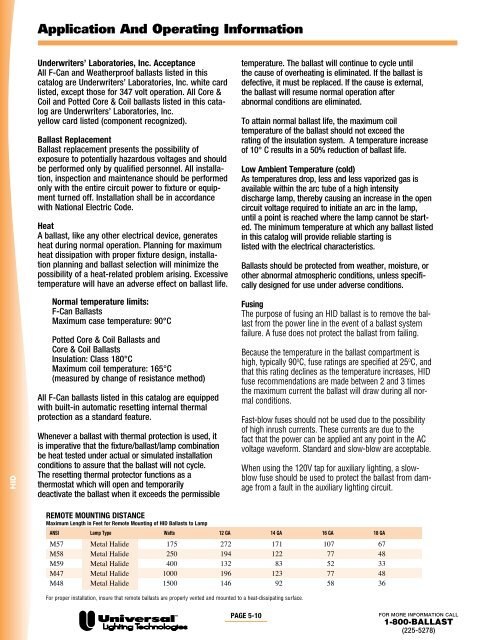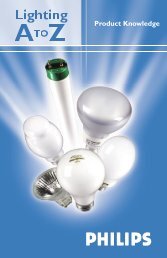triad® electronic ballasts - Conserve-A-Watt Lighting, Inc
triad® electronic ballasts - Conserve-A-Watt Lighting, Inc
triad® electronic ballasts - Conserve-A-Watt Lighting, Inc
Create successful ePaper yourself
Turn your PDF publications into a flip-book with our unique Google optimized e-Paper software.
Application And Operating InformationHIDUnderwriters’ Laboratories, <strong>Inc</strong>. AcceptanceAll F-Can and Weatherproof <strong>ballasts</strong> listed in thiscatalog are Underwriters’ Laboratories, <strong>Inc</strong>. white cardlisted, except those for 347 volt operation. All Core &Coil and Potted Core & Coil <strong>ballasts</strong> listed in this catalogare Underwriters’ Laboratories, <strong>Inc</strong>.yellow card listed (component recognized).Ballast ReplacementBallast replacement presents the possibility ofexposure to potentially hazardous voltages and shouldbe performed only by qualified personnel. All installation,inspection and maintenance should be performedonly with the entire circuit power to fixture or equipmentturned off. Installation shall be in accordancewith National Electric Code.HeatA ballast, like any other electrical device, generatesheat during normal operation. Planning for maximumheat dissipation with proper fixture design, installationplanning and ballast selection will minimize thepossibility of a heat-related problem arising. Excessivetemperature will have an adverse effect on ballast life.Normal temperature limits:F-Can BallastsMaximum case temperature: 90°CPotted Core & Coil Ballasts andCore & Coil BallastsInsulation: Class 180°CMaximum coil temperature: 165°C(measured by change of resistance method)All F-Can <strong>ballasts</strong> listed in this catalog are equippedwith built-in automatic resetting internal thermalprotection as a standard feature.Whenever a ballast with thermal protection is used, itis imperative that the fixture/ballast/lamp combinationbe heat tested under actual or simulated installationconditions to assure that the ballast will not cycle.The resetting thermal protector functions as athermostat which will open and temporarilydeactivate the ballast when it exceeds the permissibletemperature. The ballast will continue to cycle untilthe cause of overheating is eliminated. If the ballast isdefective, it must be replaced. If the cause is external,the ballast will resume normal operation afterabnormal conditions are eliminated.To attain normal ballast life, the maximum coiltemperature of the ballast should not exceed therating of the insulation system. A temperature increaseof 10° C results in a 50% reduction of ballast life.Low Ambient Temperature (cold)As temperatures drop, less and less vaporized gas isavailable within the arc tube of a high intensitydischarge lamp, thereby causing an increase in the opencircuit voltage required to initiate an arc in the lamp,until a point is reached where the lamp cannot be started.The minimum temperature at which any ballast listedin this catalog will provide reliable starting islisted with the electrical characteristics.Ballasts should be protected from weather, moisture, orother abnormal atmospheric conditions, unless specificallydesigned for use under adverse conditions.FusingThe purpose of fusing an HID ballast is to remove the ballastfrom the power line in the event of a ballast systemfailure. A fuse does not protect the ballast from failing.Because the temperature in the ballast compartment ishigh, typically 90 O C, fuse ratings are specified at 25 O C, andthat this rating declines as the temperature increases, HIDfuse recommendations are made between 2 and 3 timesthe maximum current the ballast will draw during all normalconditions.Fast-blow fuses should not be used due to the possibilityof high inrush currents. These currents are due to thefact that the power can be applied ant any point in the ACvoltage waveform. Standard and slow-blow are acceptable.When using the 120V tap for auxiliary lighting, a slowblowfuse should be used to protect the ballast from damagefrom a fault in the auxiliary lighting circuit.REMOTE MOUNTING DISTANCEMaximum Length in Feet for Remote Mounting of HID Ballasts to LampANSI Lamp Type <strong>Watt</strong>s 12 GA 14 GA 16 GA 18 GAM57 Metal Halide 175 272 171 107 67M58 Metal Halide 250 194 122 77 48M59 Metal Halide 400 132 83 52 33M47 Metal Halide 1000 196 123 77 48M48 Metal Halide 1500 146 92 58 36For proper installation, insure that remote <strong>ballasts</strong> are properly vented and mounted to a heat-dissipating surface.PAGE 5-10FOR MORE INFORMATION CALL1-800-BALLAST(225-5278)




